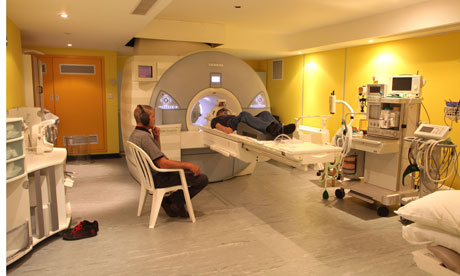
The following correction was printed in the Guardian's Corrections and clarifications column, Friday 10 December 2010
An article examining the way in which brain scans may be used to help surgeons operate more successfully on children suffering from epilepsy stated that 500 people die each year as a result of the neurological disorder. To clarify: around 1,000 die each year; 500 as a direct result of accidents involving epilepsy, such as a bang on the head during a fit, and a further 500 from Sudden Unexplained Death in Epilepsy (Sudep), the exact cause of which is unknown.
Heather Murphy first noticed something was wrong with her son Aidan when he was three. He kept falling over backwards in a way that did not look like the usual toddler tumbles. Medical examination found that Aidan had epilepsy caused by a tumour in his brain. That was 12 years ago: since then the Southend schoolboy's life has been dominated by seizures, anti-epileptic drugs, meeting doctors – and trying not to let the condition affect his life too much.
Which is why at just after 2pm on a Wednesday afternoon in the basement of Great Ormond Street hospital in central London, Aidan is climbing on to a curved sliding tray. The 15-year-old lies down and is drawn slowly back into a machine that resembles an underwater research vessel. It is actually a huge magnetic resonance imaging (MRI) scanner, for studying the brain – and Aidan is about to undergo a process that could change, or even help save, his life. The outcome will help Aidan, his family and doctors to decide whether he should have a complex and delicate form of brain surgery that could cure him, but holds the risk of going badly wrong.
Radiographer Tina Banks tells Aidan to move, and he wiggles his left hand from side to side. Those small movements lead to increases in the amount, and changes to the location, of the blood flowing around his brain, revealing which part of his brain is controlling the movement along his right and left sides.
Banks is producing three separate images of Aidan's brain, taken when he is moving either hand, and each made up of a sequence of different pictures called "slices". Each slice involves Banks issuing the same commands to move and rest and also a short burst of high-pitched noise so loud that Aidan and father Fred, sitting near his son's feet, both have to wear headphones.
About 456,000 people in the UK have epilepsy, including about one in 280 children – and some 75 people a day are diagnosed with it. Every year about 500 people will die from epilepsy, mainly by choking, drowning or banging their head during a fit. Many patients manage their condition using medication, but others can be helped by surgery.
Aidan's functional MRI (fMRI) scan measures the changes in blood flow related to neural activity in the brain Because the blood is oxygenated and thus magnetic, it can be detected and measured using fMRI. That also reveals to doctors which parts of the brain control which vital functions such as memory, speech, language and movement. (It is also used to investigate other brain-related conditions such as how people with dyslexia interact with text and how people with anorexia process information about food.) For patients who may be suitable for surgery, such as Aidan, the fMRI can tell the surgeon where to work and where to avoid – creating a roadmap of the brain.
Great Ormond Street is the first UK hospital to offer the technique to children and attracts patients from all over the world, with its excellence in paediatric surgery and the fact that it has the largest team of clinical and research paediatric neuropsychologists in the UK. "About 30-40 children a year undergo fMRI scanning here ahead of potential epilepsy surgery," says consultant Dr Peter Rankin. "It is used both to assess a child's suitability and as a guide to a surgeon. If fMRI discovered that the region of the brain causing a child's epilepsy was also responsible for critical cognitive functioning, such as language, then the child would be considered unsuitable."
Rankin says that more children than ever are being diagnosed with neurological disorders – partly because diagnostic methods, such as neuro-imaging, have improved. Epilepsy has many causes: the brain's failure to develop normally, either in utero or in early life; a brain tumour, as is the case for Aidan; or a lack of oxygen, perhaps during a difficult birth. "In such cases it can be very challenging to know when to operate because if the problem is in the brain's left hemisphere, where language is, then you might lose language altogether," he explains.
Aidan's tumour is in his right temporal lobe. That is where the electrical impulses causing his epileptic fits come from. He already knew the tumour was growing and was worryingly deep in his brain. The fMRI reveals another complication: it is very close to the part of his brain controlling his left side. "Surgery would risk giving him a weakness down the left side of his body," explains Heather Murphy.
Aidan and his parents are unsure what to do. Although Aidan leads a fairly normal life and is doing fine at school, the epilepsy leaves him tired. Different drugs he has taken since last year have reduced the number of seizures. But he is tempted to have surgery at some point so that he can work and drive a car.
Yet surgery is a frightening prospect – a last resort. William Harkness, Great Ormond Street's main epilepsy surgeon, says that any operation would have a 70% chance of leaving Aidan seizure-free hopefully for life. But, adds Heather, "we think that one day we will probably opt for the surgery to enable Aidan to have a better quality of life."

